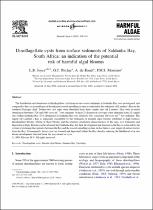 ResearchSpace
ResearchSpace
Dinoflagellate cysts from surface sediments of Saldanha Bay, South Africa: an indication of the potential risk of harmful algal blooms
JavaScript is disabled for your browser. Some features of this site may not work without it.
- ResearchSpace
- →
- Research Publications/Outputs
- →
- Journal Articles
- →
- View Item
| dc.contributor.author |
Joyce, LB

|
en_US |
| dc.contributor.author |
Pitcher, GC

|
en_US |
| dc.contributor.author |
Du Randt, A

|
en_US |
| dc.contributor.author |
Monteiro, Pedro MS

|
en_US |
| dc.date.accessioned | 2007-01-20T12:35:35Z | en_US |
| dc.date.accessioned | 2007-06-07T10:09:32Z | |
| dc.date.available | 2007-01-20T12:35:35Z | en_US |
| dc.date.available | 2007-06-07T10:09:32Z | |
| dc.date.issued | 2005-02 | en_US |
| dc.identifier.citation | Joyce, LB, et al. 2005. Dinoflagellate cysts from surface sediments of Saldanha Bay, South Africa: an indication of the potential risk of harmful algal blooms. Harmful Algae, vol. 4(2), pp 309-318 | en_US |
| dc.identifier.issn | 1568-9883 | en_US |
| dc.identifier.uri | http://hdl.handle.net/10204/1428 | en_US |
| dc.identifier.uri | http://hdl.handle.net/10204/1428 | |
| dc.description.abstract | The distribution and abundance of dinoflagellate cysts from recent coastal sediments in Saldanha Bay, was investigated, and compared to the cyst assemblages of the adjacent coastal upwelling system as reflected in the sediments of Lambert's Bay on the southern Namaqua shelf. Twenty-two cyst types were identified from three sample sites of Lambert's Bay with recorded abundances between 1726 and 1863 cysts ml(-1) wet sediment. At least 21 distinctive cyst types were identified from 32 sample sites within Saldanha Bay. Cyst abundance in Saldanha Bay was relatively low, averaging 116 cysts ml (-1) wet sediment. The region off Lambert's Bay is especially susceptible to the formation of harmful algal blooms attributed to high biomass dinoflagellate blooms. Owing to these blooms and the retentive circulation characteristics of this area, cyst formation and deposition is high. Blooms can be advected into Saldanha Bay, but their development and duration in the Bay is restricted by the system of exchange that operates between the Bay and the coastal upwelling system, in that there is a net export of surface waters from the Bay. Consequently, fewer cysts are formed and deposited within the Bay thereby reducing the likelihood of in situ bloom development initiated from the excitement of cysts. | en_US |
| dc.format.extent | 595955 bytes | en_US |
| dc.format.mimetype | application/pdf | en_US |
| dc.language.iso | en | en_US |
| dc.publisher | Elsevier Science BV | en_US |
| dc.rights | Copyright: 2005 Elsevier Science BV | en_US |
| dc.subject | Harmful algal blooms | en_US |
| dc.subject | Dinoflagellate cysts | en_US |
| dc.subject | Coastal upwelling | en_US |
| dc.subject | Saldanha bay | en_US |
| dc.subject | Marine | en_US |
| dc.subject | Freshwater biology | en_US |
| dc.title | Dinoflagellate cysts from surface sediments of Saldanha Bay, South Africa: an indication of the potential risk of harmful algal blooms | en_US |
| dc.type | Article | en_US |
| dc.identifier.apacitation | Joyce, L., Pitcher, G., Du Randt, A., & Monteiro, P. M. (2005). Dinoflagellate cysts from surface sediments of Saldanha Bay, South Africa: an indication of the potential risk of harmful algal blooms. http://hdl.handle.net/10204/1428 | en_ZA |
| dc.identifier.chicagocitation | Joyce, LB, GC Pitcher, A Du Randt, and Pedro MS Monteiro "Dinoflagellate cysts from surface sediments of Saldanha Bay, South Africa: an indication of the potential risk of harmful algal blooms." (2005) http://hdl.handle.net/10204/1428 | en_ZA |
| dc.identifier.vancouvercitation | Joyce L, Pitcher G, Du Randt A, Monteiro PM. Dinoflagellate cysts from surface sediments of Saldanha Bay, South Africa: an indication of the potential risk of harmful algal blooms. 2005; http://hdl.handle.net/10204/1428. | en_ZA |
| dc.identifier.ris | TY - Article AU - Joyce, LB AU - Pitcher, GC AU - Du Randt, A AU - Monteiro, Pedro MS AB - The distribution and abundance of dinoflagellate cysts from recent coastal sediments in Saldanha Bay, was investigated, and compared to the cyst assemblages of the adjacent coastal upwelling system as reflected in the sediments of Lambert's Bay on the southern Namaqua shelf. Twenty-two cyst types were identified from three sample sites of Lambert's Bay with recorded abundances between 1726 and 1863 cysts ml(-1) wet sediment. At least 21 distinctive cyst types were identified from 32 sample sites within Saldanha Bay. Cyst abundance in Saldanha Bay was relatively low, averaging 116 cysts ml (-1) wet sediment. The region off Lambert's Bay is especially susceptible to the formation of harmful algal blooms attributed to high biomass dinoflagellate blooms. Owing to these blooms and the retentive circulation characteristics of this area, cyst formation and deposition is high. Blooms can be advected into Saldanha Bay, but their development and duration in the Bay is restricted by the system of exchange that operates between the Bay and the coastal upwelling system, in that there is a net export of surface waters from the Bay. Consequently, fewer cysts are formed and deposited within the Bay thereby reducing the likelihood of in situ bloom development initiated from the excitement of cysts. DA - 2005-02 DB - ResearchSpace DP - CSIR KW - Harmful algal blooms KW - Dinoflagellate cysts KW - Coastal upwelling KW - Saldanha bay KW - Marine KW - Freshwater biology LK - https://researchspace.csir.co.za PY - 2005 SM - 1568-9883 T1 - Dinoflagellate cysts from surface sediments of Saldanha Bay, South Africa: an indication of the potential risk of harmful algal blooms TI - Dinoflagellate cysts from surface sediments of Saldanha Bay, South Africa: an indication of the potential risk of harmful algal blooms UR - http://hdl.handle.net/10204/1428 ER - | en_ZA |





